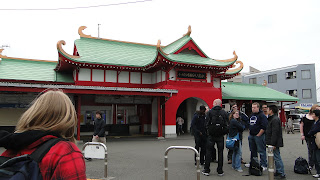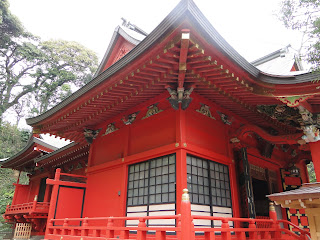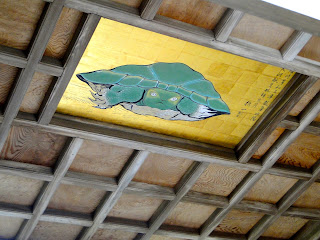School field trip! Sounds awesome, right?
It was a happy trip, and I was excited about staying in a ryokan (Japanese traditional inn) for one night. Although I wished that people whom I shared the room with would be a little respectful and considerate. My blog probably isn't the best place to complain, but I tried to be patient. Yep.
So anyways, the trip starts on Saturday morning with a 3 hour lecture on the history of places we would be heading to, then we took a train to Enoshima from Shinjuku. After done sight-seeing in Enoshima, we headed to the ryokan at Zushi, and the next day we're off to Kamakura and headed back home around 5 (reached Shinjuku station at around 6).
Enoshima (江ノ島, shima means 'island') is a small island, about 4km in circumference. It's part of Fujisawa city, and it is adjacent to Tokyo and Yokohama.
Enoshima station has a beautiful architecture. I wouldn't recognize it as a station if I didn't know how to read kanji and if I didn't see the ticket counters near the gate :)
From the station, we walked across a long bridge called Benten-bashi (Benten Bridge). Benten is a famous goddess worshipped here. In the past, it was said that Minamoto Yoritomo's prayer to win over the Fujiwara clan was granted. Also, Tokugawa Ieyasu, the founder of Tokugawa Shogunate, made the Enoshima Benten the official prayer hall for the Tokugawa family.
Along the bridge, there was a huge warning sign of tobi (the actual translation according to Google Translate is 'kite', but if I look up the Japanese dictionary it is described as a family of taka, a 'hawk').
Speaking of the devil, I found one very close to me. According to vocal announcements near the area, these kites might snatch your food and belongings, and sometimes graze you. Luckily I didn't experience any unfortunate accidents with the kites :)
Before you can reach the temple, you have to hike quite a height. Starting with this jade-colored Bronze Torii gate, the journey begins.
You will pass a lot of shops on the way, and they sell souvenirs as well as local delicacies. The most strongly recommended delicacies to buy are Tako Senbei (very thin rice crackers made with real octopus) and shirasu (シラス, or translated as whitebait). Shirasu is a type of small white fish, and in Indonesia a similar fish called
teri Medan have similar constitution.
After several flight of steps, we finally reached the Enoshima Jinja. Well, a confusion between a
jinja (shrine) and
tera (temple) are often made. Basically, a shrine is for Shinto-ism and a temple is for Buddhism. This red gate is known as
torii.
Tired of climbing the stairs? Well, you can take the escalator! Pay 750 yen and you will have access to very useful escalators around the temple. A mix of traditional and modern stuffs ;)
Before you enter a shrine, there is normally a place to wash your hands and sometimes your mouth. This is to 'cleanse' your spirit.
Below is chi no wa (茅の輪). According to the legend, back then there was a god in disguise who asked two brothers for lodging. The richer younger brother was stingy, and wasn't willing to let the god in, but the poorer older brother was kind-hearted and let the god stay in his house. Afterwards, the god told the brother to make a ring out of grass and walk pass through it to prevent disease and bad luck that was about to happen.
There were a lot of people lining up for the chi no wa, but since I was there, why not try passing it? :)
Well, the journey continues. A lot of unique buildings around the shrine. It's a huge place.
Somehow we found handprints of famous kabuki actors. We tried matching our hand sizes there :)
Narcissistic moment here. Ahem. Well, the view was great because we were standing on a high ground.
When we came there, the momiji (maple) leaves were red. It's such a rare sight because normally in a 4-season country leaves turn red only in autumn.
And next is Suikinkutsu (水禽窟), in which an underground cave / hole was dug below a rinsing place. After washing your hands, if there is some water left in the water dipper, pour it onto the rocks on the ground connected to the Suikinkutsu, and afterwards the echoes from the water dripping will be heard. The sound of the echoes are very beautiful, as if the sound was made by a brass instrument.
Also in Enoshima is Cocking Garden. The garden was made by British trader in the past. A lot of the flowers haven't bloomed yet, but there are some really beautiful ones, like these ones:
Inside the garden, there is a French cafe called Lon Cafe (the sign looks like Loneafe LOL). They sell pancakes and french toasts, and the smell was really good. It seems that this cafe is very popular, judging from the number of people waiting to be seated outside. Well, they also have outdoor seats where you can enjoy nice views of Enoshima. If I have more free time the next time I come back to Enoshima (hopefully), I will definitely check it out :)
Enoshima beach is also known as "the Miami Beach of Asia" because apparently a lot of people think it looks like Miami beach in Florida, US. I don't remember what Miami looks like but anyways it's a beautiful beach and there was a sign of friendship.
There was a key located at just below the sign, and apparently it's a symbol of friendship. It's like giving your house key to someone else you trust and allowing them to come over at any time :)
Ok, almost there. There's still this Sea Candle to explore. It is actually a lighthouse and I heard in the past it used to be just called "Observation Tower" or "Panoramic Tower". Perhaps it was inspired by the establishment of the new Sky Tree...?
The Sea Candle is located at the center of the Cocking Garden. You can either take the stairs or the elevator to go up :)
Nice view from the top deck of the tower! :)
You should be able to see Oshima (anothe island) to the south, Mt. Fuji to the west, and the Miura peninsula to the east.
On the way back to the exit, we spotted a couple stray cats. They're plump, round and fluffy. Very cute <3
As I told you before, between the entrance of the shrine and the main hall lies an array of shops. Since Enoshima is surrounded by the sea, fresh seafood is one of the biggest attraction here and those shells on the right are the most famous seafood here. I didn't have the chance to try it because our student coordinator told me it's dangerous if it's not well cooked and I guess he's right about being cautious because it would suck if I fell sick during the trip. I'm (still) a little sad about this, but I don't want to drag the whole group down because of my stupidity :)
To be honest, I didn't know where I was walking. I was simply following the teacher and the student coordinator. Somehow they led us to this temple with a Fudou (a kind of Buddhist god with scary face and flame behind it) statue.
They sell purified salt and ash here. Didn't buy it, though :)
Speaking of which, the symbol shown below (4 triangles in a triangle) is actually Hojo's family crest. Not a Zelda crest, as my classmate mentioned during the lecture earlier that day LOL
And there's this Happo Nirami no Kame (a turtle glaring in all directions). It is a masterpiece of Hoichi Sakai and this creepy turtle wwill appear to be lookng directly at you regardless of which angle you look at it from. I tried every angle and it was really looking at me. A little creepy but AWESOME!
Enoshima shrine revolves around Benten, and to summarize, Benten married this dragon that used to be mischievous. Below, you'll see an illustration of the dragon and on the right, Benten.
Below is a huge dragon statue. Still related to the Benten legend, I assume.
On the way to the exit, you will pass this road with padlocks written with names of couples. With the legend of Benten and the dragon, Enoshima is famous for prayers and wishes for long-lasting couples. There is Ryuren no Kane (the Bell of Dragon's Love, which we didn't have chance to visit), and the ema (wooden postcard looking board for you to write your wishes on) is pink-colored. Very unusual for an ema. Well, if you write your names on the padlock, lock it up, throw away the key into the sea, legend says that you will be 'locked up' together with your partner forever.
Alrighty, last part of the trip: FOOD.
Tako senbei is a must-buy. The original shop is located close to the Bronze gate (if you pass a shop where there is a long line of people waiting, then that's probably the shop). At any case, you will see this packaging on display:
They also have Kurage senbei (jelly fish rice cracker), which isn't as famous but I bought it regardless because it's a unique product.
Kurage senbei. It's HUGE, I'm warning you. The flavor is a little weak, but it's delicious. Very thin and crispy, and savory.
And this is the very famous Tako senbei. I was surprised that they didn't chop the octopus legs into small pieces. They just entered this ultra high pressure press along with rice flour and voila!
Another very very good food you have to buy here is Shirasu-pan (
shirasu bread). It looks like small deep fried balls. I didn't have the chance to take a photo of it because it took me 20 minutes lining up for the tako senbei and I felt bad for my teacher who waited for me while letting everyone go first. It's filled with cheese and
shirasu. I gave one for my teacher, and even she said it's really really really delicious. If I can buy 20 of them that time, I WOULD.
Okay, more stories from the field trip coming up next! :)






































































































